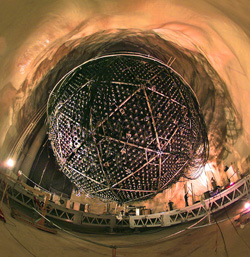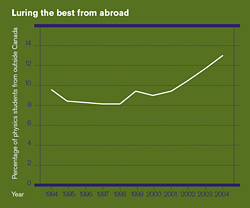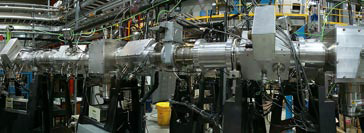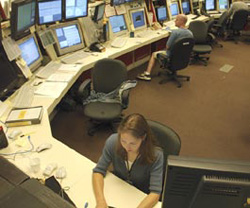 |
A quest for balance in Canada By Glennda Chui TRIUMF in Vancouver is the Canadian national laboratory that specializes in radioactive-beam physics. Photo courtesy of TRIUMF |
Canadian subatomic physics has a lot going for it: sparkling new hardware, an influx of bright young minds, and key roles in international projects. But only by doubling its operating budget can it live up to that potential, a new report suggests.
 |
|
Brigitte Vachon was able to buy a high-performance 160-processor computer system for her research group but still needs to do the maintenance by herself or with her postdocs. She is shown here at Fermilabs DZero experiment, on which she collaborates. Photo courtesy of Lawrence Berkeley National Laboratory |
 |
| The Sudbury Neutrino Observatory was one of the early underground experiments in a site that has expanded to become SNOLab. Photo courtesy of Lawrence Berkeley National Laboratory |
 |
| (Click image for larger version) |
| There's been a sharp upturn in the number of foreign students studying physics in Canada. Source: Statistics Canada |
Brigitte Vachon is taking full advantage of a happy collision of events in Canadian particle physics.
Lured to McGill University by a program aimed at attracting talented researchers to Canada, she collaborates on experiments at the worlds most powerful particle accelerator and is gearing up to do the same at the Large Hadron Collider in Geneva, which will be seven times more powerful still.
Her status as a Canada Research Chair gives her a bit of extra research money and special access to grants, allowing her to buy a high-performance 160-processor computer system that is used exclusively for particle physics.
"This money has really made a difference," says Vachon, who now works about three hours away from the small town in Quebec where she grew up. "We can do anything in a short period of time. We dont have to wait to access other peoples computing resources."
Theres just one thing: "We have not been able to hire a full-time technician to look after it and fix things when anything goes wrong," she says. "We dont have a choiceeveryone has to chip in. But if these people are busy trying to maintain a computer system, they are not doing physics."
That, in a nutshell, is the predicament for physicists all over the country, according to a recent report that defines the aspirations of people in the field. Perspectives on Subatomic Physics in Canada 20062016 was drawn up by a committee of 14 prominent scientists for the Natural Sciences and Engineering Research Council, or NSERC.
While the field has enjoyed an injection of C$75 million for hardware over the past five years, operating budgets have not kept pace. If this continues, the report says, Canadians could find themselves running cutting-edge labs in which their own scientists cannot afford to do experiments.
The report comes at a time when a burst of growth and revitalization is bringing Canada more young physicists and more sophisticated machines with which to probe the universe.
SNOLab, an extension of Sudbury Neutrino Observatory with three times the floor space, will be the worlds deepest underground laboratory for years to come, an ideal place to search for dark matter and other shadowy phenomena. TRIUMF, the Canadian national laboratory in Vancouver, is the world leader in producing radioactive beams of fast-moving, exotic isotopes. The beams are used, among other things, to simulate conditions in the hearts of exploding stars, where all but a few of the elements that make up our world are violently wrenched into being and flung out into the universe.
Canada collaborates
Because the Canadian subatomic physics community is relatively smallfewer than 250 researchers working in particle, nuclear, and theoretical physicsit concentrates on a few well-chosen areas, leveraging its expertise and brainpower by connecting to international projects.
Vachon, for instance, is part of the DZero experiment at Fermilabs Tevatron collider, which announced in February that it had observed an extremely rare type of collision that creates a single top quark. She also shuttles back and forth to CERN, the European particle physics facility near Geneva, where the Large Hadron Collider will soon launch a long-awaited search for the Higgs boson and other fundamental quantum weirdness just beyond our reach. Canada is making important contributions to one of the colliders experiments, called ATLAS.
"Part of my responsibility is training scientists," Vachon says, "and you cant get away with not spending time at the lab, seeing and participating and knowing what its like to be there in the middle of the action, trying to make the detector work and trying to fix things when they go wrong." Although funding constraints have not had an impact on travel yet, she adds, "I certainly worry about the future."
Canada also participates in T2K, which beams neutrinos from Tokai, Japan, to a detector more than 295 km away in Kamioka in the hope of learning more about these elusive particles. Canadians make up one of the largest non-Japanese groups involved in those experiments. "We have been there from the start. We contributed to the design of the facility itself," says Jean-Michel Poutissou, science director at TRIUMF.
Canadian researchers built major components of the BaBar detector at Stanford Linear Accelerator Center and collaborate on the ZEUS experiment at DESY, the German national particle physics laboratory.
As for the next big thingthe International Linear Colliderthe long-range report says Canada should be "a strong player" in the project, vigorously carrying out research and development over the next few years to prepare itself for major involvement. TRIUMF is already involved in the detector development for the collider.
In late April, TRIUMF for the first time sent representatives to a meeting of the TESLA Technology Collaboration, which is a key player in designing superconducting components for the linear collider. "For want of a better word, its a fishing trip to see if we have any expertise that is needed or overlaps with what is needed for ILC," says Shane Koscielniak, an accelerator physicist at the laboratory and the only Canadian member of the colliders Global Design Effort.
 |
| A beamline at TRIUMF used in studies of the behavior and interactions of rare nuclear isotopes. Photo courtesy of TRIUMF |
 |
| Perimeter Institute for Theoretical Physics is funded by the Canadian national, provincial and local governments, and major private donations. Photo courtesy of Perimeter Institute for Theoretical Physics |
An influx of internationals
More and more these days, the traffic is flowing in the other direction, too, as scientists from around the world travel to Canada to take advantage of what its research institutions have to offer.
The number of graduate students enrolled in subatomic physics in Canada rose 42 percent between 2001 and 2005, in part due to an influx of foreign students after the September 11 attacks led to tighter visa restrictions in the United States.
At the same time, about 35 percent of the subatomic-physics faculty at the nations universities were hired in the past five or six years, replacing a wave of retirees.
"Weve hired a whole bunch of smart young whippersnappers, and its great to see," says Kenneth Ragan, professor of physics at McGill and chairman of the committee. "These are really first-rate scientists. And as people are ramping up their research programs, more students are attracted into the discipline."
Keeping the labs running
But money is tight when it comes to running the new facilities and allowing Canadian researchers to take full advantage of them; attracting experiments from other countries; supporting the growing number of graduate students and postdocs; and keeping up with increasing travel demands as the Large Hadron Collider and other foreign facilities come online.
"We now have the strongest arguments weve had in a generation for more operating funds," Ragan says. "Well hopefully come out of it being able to use this infrastructure weve developed, which in many cases is world-class."
SNOLab, for instance, is nearing completion, its caverns and tunnels carved out of solid rock two kilometers deepproviding nearly twice the protection from interfering cosmic rays as the next-deepest lab, Italys Gran Sasso National Laboratory.
A dark matter experiment called picasso is already taking data there, "shoehorned into a little corner until we can get some space and build it up," says lab director Tony Noble. "Theres only enough space in existing facilities for people to fit small prototypes while they wait for the rest of the lab to appear."
An advisory committee is in the process of reviewing 20 proposals for SNOLab experiments, of which about half a dozen will be chosen. "It really is meant to be an international facility," Noble says. "Obviously we want to be both the hosts and participants."
He adds, "This first year were cobbling together funds to run on, but I dont think thats a viable long-term solution. I just cant believe that after putting all that time and money into it, the government would not give us enough money to operate it. Canada has a very good track record of looking after the things that it builds."
 |
| The picasso dark matter detection experiment, one of the first experiments to start operating in the new SNOLab facilities. Photo courtesy of Queens University, Canada |
Injections of funds
SNOLab is the single biggest beneficiary of the Canada Foundation for Innovation, an independent corporation created by the federal government in 1997 to manage the distribution of money for research infrastructure. The foundation has pumped C$54.5 million dollars into 23 subatomic physics projects, including $38.9 million to develop SNOLab.
Theorists also got a big shot of new money, in this case from both private and government sources. In 2000, Mike Lazaridis, founder of Research in Motion, which makes the popular BlackBerry wireless device, dug $100 million out of his own pocket to create the Perimeter Institute for Theoretical Physics. Other private donors came up with more than $20 million, the national and provincial governments kicked in more than $100 million, and the city of Waterloo offered a free site. The institute now has more than 60 resident researchers working in string theory, cosmology, quantum gravity, quantum foundations, and quantum information, and its starting to build a particle-physics group, with two half-timers hired so far, says Cliff Burgess, who is one of the two.
In March, the Canadian government announced that it would give Perimeter an additional $50 million over the next five years. "Thats a huge plus for theory," Burgess says. "Thats the kind of thing I never expected to see in my lifetime in Canada."
Meanwhile, the same Canada Research Chairs program that allowed McGill University to recruit Brigitte Vachon continues to spend $300 million per year on the effort. The goal of the program is to establish 2000 research professorships by the end of 2008. As of December, 1755 of those positions had been created, 244 of which are occupied by Canadians who had been working in other countries.
However, funding for the experimental side of subatomic-physics has remained flat when inflation is taken into account. The proposed national budget released last month appears to continue that trend, says William Trischuk of the University of Toronto, director of the Institute for Particle Physics and an ex-officio member of the NSERC report committee.
 |
| Control room scientists keep a watchful eye on the status of beams and experiments at TRIUMF. Photo courtesy of Fermilab |
Budgeting for the future
The committees report called for a doubling of the subatomic-physics budget by 2015. This would allow SNOLab to operate at full speed with full Canadian participation and allow the country to play a role in both the International Linear Collider and future upgrades of the Large Hadron Collider, without having to choose between the two.
Instead, Trischuk says, it looks like science and engineering research funded by NSERC will get a 3 or 4 percent increase at best; the full picture will not emerge until summer, when details are released. While NSERC did agree to provide half the operating money for SNOLab in the fiscal year that just began, its a one-time-only grant. The lab has asked the provincial government to make up the difference in operating funds for this year, but does not expect an answer for some time.
"Were really being backed into a corner," Trischuk says. "It was a pretty bad budget for science."
However, the figures are far from final. The process of approving the budget will take months, and with a minority government in power, there undoubtedly will be many bumps along the way.
"Here in Canada, historically we havent been as politically plugged in," Ragan says. "So thats what were struggling with now. We have pretty good reasons for arguing for increased funding; now how do we go to the political scene and make that happen?"
As for Vachon, "I would like in Canada to continue to have the freedom to pursue different avenues of research that I might find interesting," she says. "From my point of view its an exciting time to be a physicist. Were young, were eager, and we want to build our group. We want to participate in this new generation of experiments." See the full version of Canadas long-range plan in subatomic physics along with a non-experts guide at www.subatomicphysics.ca
Click here to download the pdf version of this article.






